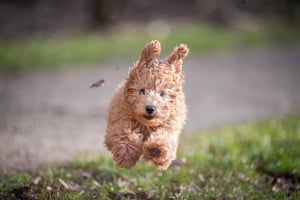Dog walking can be a great way to exercise and bond with your pup. But it can also be overwhelming...
Dog Training for 10 Weeks Old Puppies: What to Expect & How to Prepare
Training a 10 weeks old puppy is a wonderful way to nurture its potential and set the pup up for success. It is also an excellent way to bond with the pup and provide them with a safe, secure environment. This article will discuss the important aspects of training a 10 weeks old puppy, what to expect and how to prepare for it.
Why is Training Important for 10 Weeks Old Puppies?
Training plays an important role in the development of a 10 weeks old puppy. It helps the pup to become familiar with its new environment, teaches them socialization skills, and establishes boundaries and expectations. Training also helps to build a relationship of trust and respect between the puppy and its owner. By providing the puppy with the necessary tools and guidance, the pup can learn to become a well-mannered, obedient, and well-socialized family member.
Training also helps to reduce stress and anxiety in puppies. It helps the pup to adjust to its new home and surroundings, and to feel secure and content in its new environment. Training also helps to reduce the risk of behavior problems in the future. By teaching the puppy basic commands and socialization skills, the pup can learn to become a responsible, reliable, and well-behaved pet.
What to Expect from Dog Training 10 Weeks Old?
When training a 10 weeks old puppy, it is important to understand that the pup is still learning and developing. The pup has limited attention span and may be easily distracted. It is important to be patient and consistent when training the pup and to provide positive reinforcement for desired behaviors. Training sessions should be short and positive, and should focus on teaching the pup basic commands and socialization skills.
When training a 10 weeks old puppy, it is important to establish a routine. This will help the pup to feel more secure and comfortable in its new environment. The pup should also be taught basic commands such as sit, stay, down, and come. The pup should also be introduced to people and other pets in a controlled and positive environment.
It is important to remember that training a 10 weeks old puppy takes time and patience. It is important to be consistent with the training and to provide positive reinforcement and rewards for desired behaviors. It is also important to be patient and understanding of the pup's limitations and to provide the pup with a safe and secure environment.
How to Prepare for Dog Training 10 Weeks Old?
When preparing for dog training 10 weeks old, it is important to create a safe and secure environment for the pup. This includes providing the pup with a comfortable bed, toys, and treats. It is also important to create a routine for the pup and to establish a consistent schedule for feeding, exercising, and training.
It is also important to provide the pup with the necessary tools and supplies for training. This includes a leash, collar, and treats. It is also important to provide the pup with positive reinforcement such as verbal praise and treats for desired behaviors. Finally, it is important to be patient and understanding of the pup's limitations and to provide the pup with a safe and secure environment.
In conclusion, training a 10 weeks old puppy is an important and rewarding experience. It is important to provide the pup with a safe and secure environment, establish a routine, and provide the pup with the necessary tools and supplies for training. It is also important to be patient and consistent with the training and to provide positive reinforcement and rewards for desired behaviors.
Tips for Dog Training 10 Weeks Old
- Provide a safe and secure environment for the pup.
- Establish a routine for the pup.
- Provide the pup with the necessary tools and supplies for training.
- Be patient and consistent with the training.
- Provide positive reinforcement and rewards for desired behaviors.
- Teach the pup basic commands such as sit, stay, down, and come.
- Introduce the pup to people and other pets in a controlled and positive environment.



